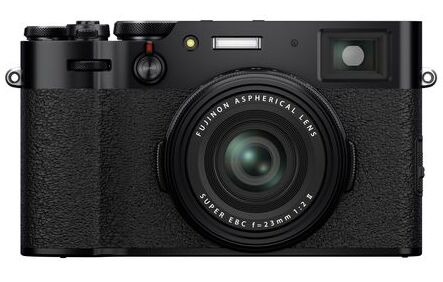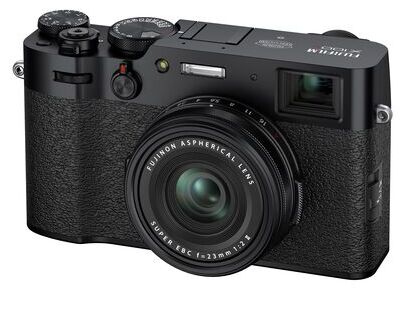The X100V is the fifth camera in Fujifilm’s X100 series since the original model debuted nearly a decade ago. Through each subsequent iteration, Fujifilm has made its compact lens large and premium lens camera increasingly capable, and this latest model takes the main bits of Fujifilm’s high-end X-Pro3 interchangeable lens and slides them into a much smaller package.
This means you get the latest APS-C 26MP X-Trans sensor and processor combination, the promise of greatly improved autofocus and the best set of video features we’ve seen in a compact primary lens camera. But it doesn’t stop there: the lens has been redesigned, the ergonomics refined, the visor revisited and much more.
Lens quality
One of the great updates of the new X100V is that the lens has been completely redesigned; inside, anyway. It’s almost identical on the outside to stay compatible with the company’s existing wide-angle and telephoto adapters. A new optical formula adds a more aspheric element than its predecessors, and the built-in ND filter is stronger, at four stops than the previous three models.
The Fujifilm X100V offers two significant improvements over its X100F predecessor in terms of shooting capabilities. The first is the redesigned 23mm f/2 lens, which now includes two aspherical elements instead of just one, theoretically improving resolution and reducing distortion. The second is the snappier autofocus, made possible by the new X-Processor 4.
Although the focal length and aperture remain the same as the X100F, the autofocus performance is strong, though not quite on par with a Fujifilm X-T3 paired with a 23mm f/2 lens, particularly in low-light situations. However, the X100V’s autofocus rarely misses focus or results in missed shots. The Face/Eye detection is reliable when shooting people, and the tracking autofocus mode tenaciously follows objects if switched to continuous AF using the side switch.
In fact, for a pocketable camera with an f/2 lens, the autofocus performance is very good, and the X100V has decent burst performance to capture fleeting moments. When using an SDHC UHS-II card with 250MB/s write speeds, the camera achieved a slightly lower than claimed maximum burst rate of around 10fps, with the buffer filling up after around 40 JPEGs and 20 Raws. While not a sports camera, the X100V is capable of capturing action and fast-moving subjects.
In addition to the major improvements in shooting capabilities, the X100V also boasts some minor yet significant enhancements over its predecessor, the X100F. The first improvement is the hybrid viewfinder, which is similar to the Fujifilm X-Pro3. The viewfinder can be used as a modern electronic viewfinder (EVF) or an old-fashioned optical viewfinder, which can be switched using a switch on the front of the camera. In both modes, exposure information is displayed around the edges of the viewfinder and can be toggled on or off using the ‘disp/back’ button. The optical viewfinder has been improved with a magnification boost of 0.52x, but it’s the electronic viewfinder that’s particularly impressive, with a sharp resolution of 3.69 million dots and a magnification of 0.66x that is excellent for a camera of this size.
The X100V also boasts improved battery life over its predecessor. The industry-standard CIPA rating estimates 350 shots per charge, which is a significant improvement of 270 shots over the X100F. In real-world tests, this equated to approximately five hours of intensive street shooting. Therefore, carrying a spare Fujifilm NP-W126S battery or an external power delivery charger that can charge the X100V directly via the USB-C port is a good idea, especially if you’re planning a long day of shooting.
There are four autofocus modes:
A single point, which allows you to vary the relative size of that point
zone, where an area larger than variable sizes is given
Wide/Tracking, which decides between many focus points throughout the frame in AF-S, and gives you a box to choose a theme to track if you’re in AF-C
Everything, which simply allows you to switch between modes by varying the size of the AF point (obtained by clicking on the joystick and manipulating the control dials)
Tracking performance in terms of how tenaciously the camera adheres to the intended theme is on par with the X-T3/X-Pro3 when using the EVF or rear screen, which means it’s pretty good if not able as the best tracking cameras out there. But the focus design of the new lens unit means that sometimes you may not be able to move fast enough to keep up with irregular subjects (uncooperative children, for example). Fujifilm says that a new focus engine gives faster speeds than previous models, and that’s true, but you really have to have the two cameras side by side to detect a difference.
Even on par with the X-T3 is the level of autofocus customization in terms of custom AF-C configuration. We doubt that X100V users are chasing cheetahs with any kind of regularity, but all settings are at least familiar if you come from another recent Fujifilm camera. In short, we believe that some of these options could be removed and therefore the menus remained simpler.
The X100 series precedes Fujifilm’s X-mount interchangeable cameras and is responsible for setting up the company on a trajectory to where it is today. For this reason, it is a particularly important product as there is X100 DNA in basically all the models that Fujifilm currently produces. All this is to say, it must be quite difficult to update these cameras in convincing ways without straying too far from the formula that made them so popular and perhaps iconic: But this is just what Fujifilm has done in the last 10 years and has been successful again with the X100V.
The X100V is an attractive well-built camera that produces beautiful images, has best-in-class video, great autofocus and optional weather sealing. Significant updates, such as a tilting touchscreen, an updated viewfinder and a redesigned lens, makes us look largely beyond their imperfections. Assuming you like the 35mm focal length, it makes a strong case as a compact photographer that is good for all kinds of photography. Photo:Fujifilm
Fujifilm X100V specifications:
| Body type | |
|---|---|
| Body type | Large sensor compact |
| Body material | Magnesium alloy, aluminum |
| Sensor | |
| Max resolution | 6240 x 4160 |
| Image ratio w:h | 1:1, 3:2, 16:9 |
| Effective pixels | 26 megapixels |
| Sensor size | APS-C (23.5 x 15.6 mm) |
| Sensor type | BSI-CMOS |
| Processor | X-Processor Pro 4 |
| Color space | sRGB, Adobe RGB |
| Color filter array | X-Trans |
| Image | |
| ISO | Auto, 160-12800 (expands to 80-51200) |
| Boosted ISO (minimum) | 80 |
| Boosted ISO (maximum) | 51200 |
| White balance presets | 7 |
| Custom white balance | Yes (3 slots) |
| Image stabilization | No |
| Uncompressed format | RAW |
| JPEG quality levels | Fine, normal |
| File format |
|
| Optics & Focus | |
| Focal length (equiv.) | 35 mm |
| Maximum aperture | F2–16 |
| Autofocus |
|
| Autofocus assist lamp | Yes |
| Manual focus | Yes |
| Normal focus range | 10 cm (3.94″) |
| Number of focus points | 425 |
| Screen / viewfinder | |
| Articulated LCD | Tilting |
| Screen size | 3″ |
| Screen dots | 1,620,000 |
| Touch screen | Yes |
| Screen type | TFT LCD |
| Live view | Yes |
| Viewfinder type | Electronic and Optical (tunnel) |
| Viewfinder coverage | 95% |
| Viewfinder magnification | 0.52× |
| Viewfinder resolution | 3,690,000 |
| Photography features | |
| Minimum shutter speed | 30 sec |
| Maximum shutter speed | 1/4000 sec |
| Maximum shutter speed (electronic) | 1/32000 sec |
| Exposure modes |
|
| Built-in flash | Yes |
| External flash | Yes (via hot shoe) |
| Flash modes | Auto, Standard, Slow Sync, Manual, Commander, off |
| Flash X sync speed | 1/4000 sec |
| Continuous drive | 11.0 fps |
| Self-timer | Yes |
| Metering modes |
|
| Exposure compensation | ±5 (at 1/3 EV steps) |
| AE Bracketing | ±5 (2, 3, 5, 7 frames at 1/3 EV steps) |
| WB Bracketing | Yes |
| Videography features | |
| Format | MPEG-4, H.264 |
| Modes |
|
| Microphone | Stereo |
| Speaker | Mono |
| Storage | |
| Storage types | SD/SDHC/SDXC card (UHS-I supported) |
| Connectivity | |
| USB | USB 3.2 Gen 1 (5 GBit/sec) |
| USB charging | Yes |
| HDMI | Yes (micro HDMI) |
| Microphone port | Yes |
| Headphone port | No |
| Wireless | Built-In |
| Wireless notes | 802.11b/g/n + Bluetooth |
| Remote control | Yes (via cable release or smartphone) |
| Physical | |
| Environmentally sealed | Yes (with optional filter holder and filter) |
| Battery | Battery Pack |
| Battery description | NP-W126S lithium-ion battery & charger |
| Battery Life (CIPA) | 420 |
| Weight (inc. batteries) | 478 g (1.05 lb / 16.86 oz) |
| Dimensions | 128 x 75 x 53 mm (5.04 x 2.95 x 2.09″) |
| Other features | |
| Orientation sensor | Yes |
| Timelapse recording | Yes |
| GPS | None |

